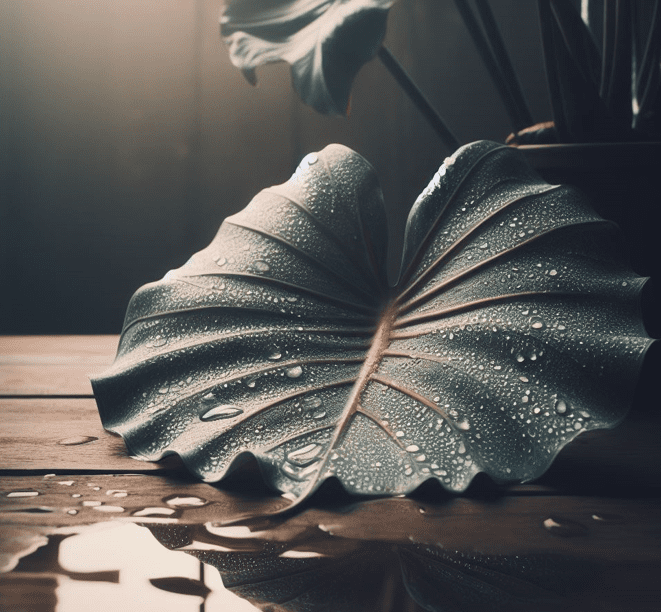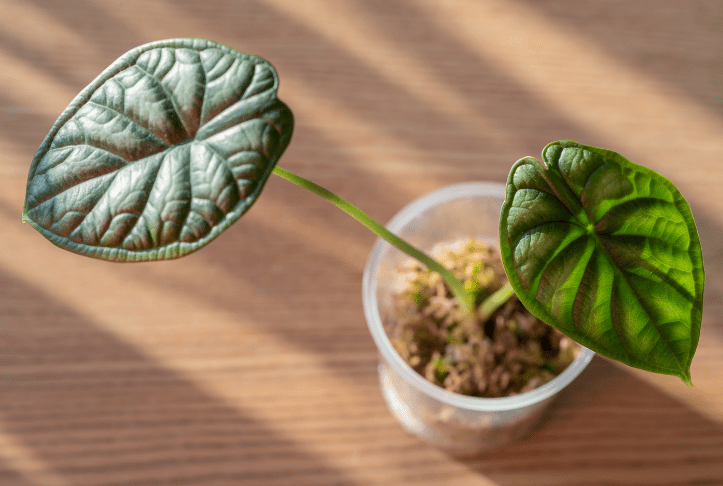
With its enchanting foliage and unique appearance, the Alocasia Dragon Scale is a houseplant that can bring a touch of the exotic into your home. This comprehensive guide will explore everything you need to know to keep this majestic plant thriving.
Understanding the Alocasia Dragon Scale
What Makes Alocasia Dragon Scale Special?
Alocasia Dragon Scale, also known as Alocasia baginda ‘Dragon Scale’, belongs to the Araceae family. It’s famed for its large, textured leaves that resemble the scales of a dragon. These plants are not just visually stunning but are also a symbol of nature’s intricate beauty.
Origin and Characteristics
Native to tropical rainforests in Southeast Asia, the Alocasia Dragon Scale is accustomed to warm and humid conditions. This plant can reach up to 2 feet in height and width, making it a perfect size for indoor cultivation.
Caring for Your Alocasia Dragon Scale
1. Light Requirements
Bright, Indirect Light: The Alocasia Dragon Scale flourishes in bright, indirect sunlight. Avoid placing it under direct sunlight, as this can cause the leaves to burn, diminishing their vibrant appearance.
Ideal Placement in the Home
A north or east-facing window is ideal. If natural light is limited, consider using grow lights to supplement.
2. Soil and Potting Mix
Well-Draining Soil: A mix comprising potting soil, perlite, and orchid bark creates an ideal environment. This blend ensures adequate drainage while retaining necessary moisture.
Repotting Tips
When repotting, select a container slightly larger than the current one. This helps prevent the plant from becoming root-bound.
3. Watering Routine
Balanced Watering: Over-watering is a common issue with the Alocasia Dragon Scale. Water when the top inch of the soil feels dry. The frequency will vary with the seasons and the humidity level in your home.
Signs of Improper Watering
Yellow leaves often indicate over-watering, while brown tips can suggest under-watering or low humidity.
4. Humidity and Temperature
Creating a Tropical Environment: Aim for 60% or higher humidity. Room temperatures between 65°F and 75°F (18°C – 24°C) are ideal.
Managing Humidity
Using a humidifier or placing the plant on a tray of wet pebbles can help maintain optimal humidity levels.
5. Fertilization Schedule
Feeding Your Plant: During the growing season (spring and summer), use a balanced liquid fertilizer every 4-6 weeks. Reduce feeding in the cooler months.
6. Pruning and Maintenance
Keeping It Tidy: Regularly prune away yellow or damaged leaves. Clean the leaves with a damp cloth to keep them dust-free and shiny.

Troubleshooting Common Issues
Yellowing Leaves
This is often a sign of over-watering. Allow the soil to dry out more between waterings.
Pest Control
Keep an eye out for pests like spider mites and mealybugs. Treat any infestations with insecticidal soap or neem oil.
Enhancing Your Alocasia Dragon Scale Experience
Displaying Your Plant
This plant makes a striking addition to any room. Consider pairing it with other tropical plants for a mini indoor jungle.
Propagation Tips
Propagate your Alocasia Dragon Scale through division during repotting. This allows you to multiply your collection or share it with friends.
The Allure of Alocasia Dragon Scale
Unique Foliage and Texture
The Alocasia Dragon Scale’s leaves are a testament to nature’s artistry. Each leaf, with its pronounced veins and scale-like texture, is a visual treat, echoing the mystical allure of a dragon’s skin.
Alocasia Baginda Dragon: A Botanical Marvel
A closer relative in the Alocasia family is the Alocasia Baginda Dragon, known for its more subtle texture but equally stunning. Both varieties belong to the ‘elephant ear’ family, characterized by their large, impressive foliage.
Cultivating the Dragon Scale Alocasia: A Comprehensive Guide
Light and Location: The Key to Vibrancy
Bright indirect light is crucial for the Dragon Scale Alocasia. This plant thrives under bright, indirect light conditions, which help maintain the vividness of its foliage. Direct sunlight, however, can be harmful, causing the leaves to lose their characteristic luster.
Soil and Watering: The Foundation of Health
Use a well-draining soil for potting mix that allows for adequate water flow. Once the top inch of the soil feels dry to the touch, watering should be done, ensuring the roots are not left in standing water.
Enhancing Your Indoor Jungle with Alocasia Baginda
Creating the Perfect Environment
To replicate the Alocasia Baginda’s natural habitat, maintain high humidity levels around the plant. This can be achieved through regular misting, using humidifiers, or placing the pot on a tray of wet pebbles.
The Silver Dragon: A Rare Gem
Another striking variety is the Alocasia ‘Silver Dragon,’ known for its silvery-green leaves that add a different hue to your Alocasia collection.
Practical Aspects of Plant Care

Buying and Payment Options
Many stores offer convenient payment options like Shop Pay or American Express when purchasing your Alocasia. Always check the nursery’s refund policy before purchasing, especially when buying rare plants like the Dragon Scale Alocasia.
Common Issues and Solutions
Over-watering and low humidity are common challenges when growing Alocasia. Yellowing leaves often indicate too much water, while brown tips can signal low humidity or under-watering.
Toxicity of Dragon Scale Alocasia
One crucial aspect to consider when bringing a Dragon Scale Alocasia into your home is its toxicity. Like many members of the Araceae family, the Dragon Scale Alocasia contains calcium oxalate crystals, which are toxic to humans and pets.
It can irritate the mouth, lips, throat, and stomach if ingested. In severe cases, it may lead to difficulty in swallowing and breathing. Therefore, keeping this plant out of reach of children and pets is advisable, ensuring a safe environment for everyone in your household.
Dragon Scale Alocasia Appearance
The Dragon Scale Alocasia is a true showstopper in terms of appearance. Its leaves are its most striking feature, with a texture reminiscent of a dragon’s scales, hence the name. The leaves are typically a deep, lush green with prominent veining, often displaying various shades of green and sometimes hints of silver.
These unique leaves are heart-shaped and can grow quite large, making the plant a focal point in any indoor garden setting. The contrast between the rugged texture and the soft, curving lines of its foliage gives this plant a majestic and exotic appearance.
Dragon Scale Alocasia Fragrance
Unlike many flowering houseplants, the Dragon Scale Alocasia is not known for its fragrance. It does not produce a noticeable scent, making it an ideal choice for those sensitive to strong floral or herbal aromas. The lack of fragrance also means it doesn’t attract insects like some scented plants, making it a cleaner choice for indoor environments.
Suggested Uses for Dragon Scale Alocasia
The Dragon Scale Alocasia is highly versatile in terms of interior decoration. It can be used as a standalone statement piece in a living room, adding an exotic and tropical feel to the space. Alternatively, it can be grouped with other plants to create an indoor jungle, where its unique texture and foliage stand out against simpler-leafed plants.
This plant is also suitable for offices or commercial spaces, bringing a touch of nature indoors. Young Dragon Scale Alocasia plants can be an interesting addition for those who enjoy terrariums or bottle gardens, provided the environment is humid and well-lit. However, due to its potential size and growth rate, it may eventually need to be relocated to a larger space.
FAQ on Alocasia Dragon Scale Care
General Care for Alocasia Dragon Scale
How do you take care of an Alocasia Dragon Scale?
To care for an Alocasia Dragon Scale, provide it with bright, indirect light, a well-draining soil mix, and maintain high humidity. Water when the top inch of soil is dry, and feed with a balanced fertilizer during the growing season. Avoid over-watering and keep the plant away from direct sunlight.
How big do Alocasia Dragon Scale plants get?
Alocasia Dragon Scale typically reaches up to 2 feet in height and width when grown indoors, depending on care and environment.
When to repot Alocasia Dragon Scale?
Repot your Alocasia Dragon Scale every 2-3 years, ideally during the springtime. It’s time to repot if you notice the roots are becoming crowded or are growing through the drainage holes.
When to water the Alocasia Dragon Scale? Water your Alocasia Dragon Scale when the top inch of the soil feels dry. This is usually about once a week, but frequency can vary based on temperature and humidity.
Uniqueness and Rarity
Is the Alocasia Dragon Scale rare?
The Alocasia Dragon Scale is considered a rare plant, particularly sought after by collectors for its unique, scale-like leaf texture.
Why is the Alocasia Dragon Scale so expensive?
Its rarity and stunning and unique appearance contribute to the Alocasia Dragon Scale’s higher price than more common houseplants.
Flowering and Dormancy
Do Alocasia Dragon Scales flower?
Yes, the Alocasia Dragon Scale can flower, producing a typical Aroid spathe and spadix. However, flowering is less common when the plant is grown indoors.
Does Alocasia Dragon Scale go dormant?
Yes, the Alocasia Dragon Scale can go dormant, especially in cooler temperatures during winter. During this time, growth slows, and the plant requires less water.
Propagation and Pollination
How to propagate the Alocasia Dragon Scale?
Propagation of the Alocasia Dragon Scale is typically done by dividing the rhizomes. This is best done during repotting in the spring.
How to pollinate Alocasia Dragon Scale?
Pollination can be done by hand if you have flowers on your Alocasia Dragon Scale. Transfer pollen from one flower’s spadix to another’s stigma using a brush or cotton swab.
Leaf Health and Misting
What are the spots on the leaves of the Alocasia Dragon Scale?
Spots on the leaves can be due to various factors, including water quality, over-watering, or pest infestation. It’s important to assess the care conditions and adjust as necessary.
Does Alocasia Dragon Scale like misting?
Yes, the Alocasia Dragon Scale benefits from misting, which helps increase humidity around the plant. However, avoid over-misting to prevent leaf issues like fungal growth.

Final Thoughts and Tips
Observation Is Key
Each Alocasia Dragon Scale has its own needs. Observe your plant closely and adjust its care accordingly.
Where to Buy
You can find the Alocasia Dragon Scale at local nurseries or through online plant shops. Always check the store’s refund and shipping policy.
Conclusion
Alocasia Dragon Scale is a magnificent plant that requires extra care but rewards you with its stunning presence. By following this guide, you’ll be well on your way to becoming an Alocasia Dragon Scale expert.
Understanding the intricacies of Alocasia Dragon Scale care, including its propagation methods, is essential for any plant enthusiast. The Alocasia Dragon Scale price varies depending on size and availability, but its striking appearance makes it a worthwhile investment. Typically reaching a 2-3 feet height, this plant adds a unique aesthetic to any indoor garden.
When comparing the Alocasia Dragon Scale vs Silver Dragon, each variety has its charm, with the Silver Dragon boasting a more silvery tone in its leaves. Caring for these plants, including the right soil choice, similar to what you would use for the Alocasia Silver Dragon, is crucial for their growth and health.
Though a bit challenging, the propagation of the Alocasia Dragon Scale is rewarding, enabling enthusiasts to expand their collection. Whether it’s the dragon scale plant care or exploring different varieties like the Alocasia Baginda or the dragon scale fern, each brings a distinct touch of nature’s wonder to your home. Remember, the dragon scale top care is a rewarding journey, offering a satisfying experience as you watch each leaf unfold.
With proper care, your Alocasia Dragon Scale will thrive and bring a unique, tropical flair to your indoor garden. Remember, the key to successful plant care is understanding your plant’s specific needs and adjusting your care routine accordingly. Happy gardening!


























